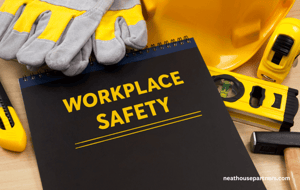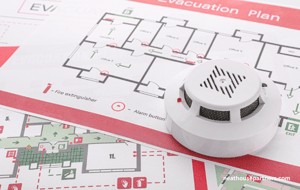Emergency Evacuations and Vulnerable Workers
Emergency Evacuations and Vulnerable Workers
James Rowland
Commercial Director James leads Account Management, Sales and Marketing at Neathouse Partners.Date
12 April 2023Updated
20 March 2024
The primary legislation that governs emergency evacuations and vulnerable workers is the Health and Safety at Work Act 1974.
This act places a duty on employers to ensure the health and safety of all employees, including those with disabilities or other vulnerabilities, during emergencies.
As a result, all employers should have Personal Emergency Evacuation Plans (PEEPs) for vulnerable workers during emergency evacuations.
PEEPs are plans that identify the individual needs and requirements of employees who may require additional assistance during an emergency, such as those with disabilities, mobility issues, or underlying health conditions.
Read on for some tips on how to create an effective emergency evacuation plan for vulnerable workers, along with training and review considerations that every business owner should factor into their planning.
Employers Legal Obligation
Employers have a legal obligation to provide PEEPs for vulnerable workers and to ensure that these plans are regularly reviewed and updated.
PEEPs are plans that identify the individual needs and requirements of employees who may require additional assistance during an emergency, such as those with disabilities, mobility issues, or underlying health conditions.
Employers must ensure that PEEPs are regularly reviewed and updated and that employees receive appropriate training on emergency procedures.
Failure to provide adequate evacuation plans and support for vulnerable workers may result in legal consequences such as fines or legal action.
Incorporating Accessibility and Inclusivity into Emergency Evacuation Planning for Vulnerable Workers
Incorporating accessibility and inclusivity into emergency evacuation planning for vulnerable workers is essential to ensure their safety during an emergency, and there are several steps you can take as an employer to make your emergency evacuation plans more accessible and inclusive.
- Conduct accessibility audits of your facilities to identify any physical barriers that could prevent or hinder the evacuation of vulnerable workers.
- Engage with employees to identify any additional needs or requirements they may have during an emergency, such as providing materials in accessible formats or ensuring that designated safe areas are accessible for all employees.
- Consider using technology to improve accessibility during emergency evacuations, such as providing visual or auditory alerts to alert employees with hearing or visual impairments.
- Provide training and support for employees who may require additional assistance during an emergency, such as offering peer support or assigning a buddy system.
- Take into account the diversity of your workforce and consider the needs of employees from different backgrounds or cultures. This could include providing materials in different languages or ensuring that employees from different cultures are aware of emergency procedures and expectations.
Identifying Vulnerable Workers in Emergency Situations
It's important to understand exactly who your vulnerable workers are and how many you have to consider when planning for emergencies so you can support and assist them properly.
Employers can identify vulnerable workers by conducting a thorough risk assessment of their workforce, which should take into account factors such as disabilities, underlying health conditions, language barriers, and cultural differences.
Employers can also engage with their employees to identify any additional needs or requirements they may have during an emergency, such as those who may require additional assistance with mobility or communication.
Employers can also consider creating a system for employees to self-identify as vulnerable workers. This could include providing a confidential system for employees to disclose any disabilities or health conditions that may require additional support during an emergency.
How To Create Effective PEEPs
Once the risk assessment has been completed to identify the potential hazards that could result in an emergency such as fire, flood, man-made incidents or terror threats, business owners should develop an emergency evacuation plan that takes into account the needs of all employees, including those who may be vulnerable. This could include individuals with disabilities, pregnant women, or employees with underlying health conditions.
The emergency evacuation plan should clearly outline the procedures that employees should follow in the event of an emergency, including how to exit the building safely and where to assemble outside. The plan should also identify any designated safe areas for employees who require additional assistance during an emergency, such as wheelchair users or those with mobility issues.
Training Employees for Emergency Evacuations
Training employees for emergency evacuations is crucial to ensure that everyone can evacuate safely and efficiently, and to do this, employers should provide training that is accessible and inclusive to all employees, including those with disabilities or other accessibility needs.
This could include providing training materials in accessible formats or ensuring that training is delivered in a way that is easy to understand for employees with limited English proficiency.
Employers should also consider the specific needs of vulnerable workers when designing training programs.
This could include providing additional training for employees who require assistance with mobility or communication or offering training in different formats to accommodate different learning styles.
It is also important to provide opportunities for employees to practice emergency procedures and to receive feedback on their performance.
This could include conducting regular drills or simulations that involve the participation of all employees, including vulnerable workers. These exercises can help to identify any areas where additional training or support may be required.
Summary
Finally, business owners should regularly review and update their emergency evacuation plan to ensure that it remains effective and relevant. By taking a proactive approach to emergency evacuations and considering the needs of all employees, including those who may be vulnerable, business owners can help to ensure the health and safety of their workforce.
Next Steps
Neathouse Partners can help you to ensure that your business is compliant with emergency evacuation plans that fully consider vulnerable workers. If you would like support with managing and understanding your employer's responsibilities regarding emergency planning, procedures and policies, please call 01244 893776 to talk to our friendly team.
Related blog posts

Promoting a Culture of Safety: Strategies for Encouraging Employee Buy-in and Engagement

Preparing for the Unexpected: Emergency Response Planning for Employers

Driving Safety Innovation: The Future of Enhanced Safety for Employers
Have questions?
Get in touch today
Contact us, and our team will get back to you within 24 hours. We value your questions and are committed to getting them answered quickly.


Hello! I am Nicky
Just fill in the form below with your details, and I will arrange for a member of our team to give you a call.
By clicking, you agree to our Privacy Policy






